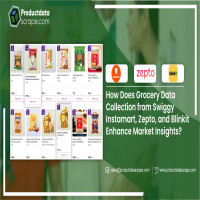How Does Pythons Ecosystem Support Scraping and Updating Shopify Product Lists?

Strong 8k brings an ultra-HD IPTV experience to your living room and your pocket.
How-Does-Python-s-Ecosystem-Support-Scraping-and-Updating-Shopify-Product-Lists-01
E-commerce data scraping is a powerful tool businesses use to extract valuable information from online platforms, providing insights that drive strategic decision-making. One key area where data scraping is highly beneficial is extracting Shopify product data. Shopify is one of the leading e-commerce platforms, and millions of businesses worldwide use it to sell their products online.
By scraping Shopify product data, businesses can gain insights into product trends, pricing strategies, and competitor analysis. This data can be used to optimize product listings, improve pricing strategies, and enhance overall business performance. Additionally, e-commerce data scraping allows businesses to keep their inventory up-to-date and accurately reflect product availability on their online store. However, it's important to note that you must perform data scraping ethically and in compliance with Shopify's terms of service to avoid legal issues. In this project, we have two main parts: comparing the new product list in Excel with our current inventory on Shopify to output a discontinued product list and updating our batteries product list and ink/toner cartridge product list based on specific conditions and templates.
Part 1: Comparing and Outputting Discontinued Products
Part 1 -Comparing-and-Outputting-Discontinued-Products-01
Extracting Shopify Product Data: Utilize Shopify's API to access and extract the current product list from the Shopify store.
Reading New Product List: Import and read the new product list from the Excel file containing the latest inventory data.
Comparing Lists: Compare the current Shopify product list and the new product list using e-commerce data scraper from Excel to identify discontinued products. Discontinued products are in the Shopify inventory but have yet to be listed in the new Excel sheet.
Outputting Discontinued Product List: Generate a comprehensive list of discontinued products, including details such as product names, SKUs, and any other relevant identifiers. This list will serve as a reference for updating the Shopify inventory.
Part 2: Updating Batteries Product List
Part 2-Updating-Batteries-Product List-01-01
Reading New Product List: Read the new product list from the Excel file, focusing on batteries.
Applying Conditions: Apply specific conditions, as outlined, to filter and identify products for updating in the batteries product list.
Extracting Product Titles from Specific Website: Utilize techniques to extract product titles from a designated website. These titles will be used to update the Shopify product list.
Formatting Shopify Product List: Format the extracted product titles into the Shopify format, ensuring consistency and accuracy.
Handling Duplicate Products: Manage duplicate products with different titles by mapping them to the correct product from the specific website, ensuring each product is correctly updated.
Updating Product Descriptions: Use the specified template for product descriptions, incorporating a compatible chart from the Excel product list. It ensures the battery product list is updated with accurate and detailed information.
Part 3: Updating Ink/Toner Cartridge Product List
Part 3-Updating-Ink-Toner-Cartridge-Product-List-01
Reading New Product List: The new product list from the Excel file focuses on ink/toner cartridges.
Comparing Lists: Compare the new ink/toner cartridge product list with the existing Shopify product list to identify discontinued products.
Updating Shopify Product List: Update the Shopify product list with the new ink/toner cartridge products, ensuring the Shopify format is followed.
Utilizing Product Description Template: Use the existing template for product descriptions, including the compatible product chart list from the Excel file. It maintains consistency in product descriptions across the Shopify store.
By meticulously following these steps, businesses can effectively update their Shopify product lists, ensuring the inventory is current and accurately reflects the products available to customers.
Why Prefer Python to Scrape and Update Shopify Product List?
Why-Prefer-Python-to-Scrape-and-Update-Shopify-Product-List-01
Python is preferred for scraping and updating Shopify product lists due to several reasons:
Ease of Use: Python is known for its simple and readable syntax, making it easier for developers to write and maintain code for web scraping and data manipulation tasks.
Rich Ecosystem: Python has a vast ecosystem of libraries and frameworks well-suited for web scrapings, such as BeautifulSoup, Scrapy, and requests. These libraries make it easy to extract and manipulate data from websites.
Support for APIs: Python strongly supports working with APIs, including Shopify's API. It makes it easy to fetch data from Shopify and update product lists programmatically.
Data Processing Capabilities: Python's data processing capabilities, including libraries like pandas, make it easy to manipulate and analyze large datasets, such as product lists.
Community Support: Python has a large and active community of developers, which means plenty of resources and tutorials are available to help with web scraping and data manipulation tasks.
Cross-Platform Compatibility: Python code can run on various platforms, including Windows, macOS, and Linux, making it a versatile choice for developing web scraping and data manipulation scripts.
Python's simplicity, rich ecosystem, and strong community support make it an excellent choice for scraping and updating Shopify product lists.
Conclusion: Python is the preferred choice for scraping and updating Shopify product lists due to its simplicity, rich ecosystem of libraries, and strong community support. With Python, developers can quickly write and maintain code for web scraping and data manipulation tasks, making it ideal for updating Shopify product lists. The ability to work with APIs, process data efficiently, and run on multiple platforms further enhances Python's suitability. Overall, Python empowers businesses to efficiently manage their Shopify stores, ensuring that their product lists are up-to-date and accurate for their customers.
At Product Data Scrape, ethical principles are central to our operations. Whether it's Competitor Price Monitoring Services or Mobile App Data Scraping, transparency and integrity define our approach. With offices spanning multiple locations, we offer customized solutions, striving to surpass client expectations and foster success in data analytics.
Know More:https://www.productdatascrape.com/scraping-and-updating-shopify-product-lists.php
#ScrapingShopifyProductLists
#UpdatingShopifyProductLists
#ExtractingShopifyProductData
#ShopifyProductListsScraping
#ExtractShopifyProductLists
#ScrapingShopifyProductListData
#CollectShopifyProductLists
#ShopifyProductDataScraper
#ScrapeProductListFromShopify
#ExtractProductTitles
Note: IndiBlogHub features both user-submitted and editorial content. We do not verify third-party contributions. Read our Disclaimer and Privacy Policyfor details.


